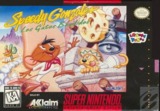The fastest mouse in all Mexico goes head to head against the dastardly cat bandits, Los Gatos Bandidos.
Speedy Gonzales is a fast placed platformer that relies on using the shape of the land and the various pitfalls and cliffs to launch Speedy into otherwise unreachable areas. Instead of collecting rings like Sonic's, our intrepid hero collects little gold wheels of swiss cheese which line his pathways suggestively outlining where the player is meant to go. His goal is to rescue the other mice who apparently are not as speedy, and therefore have been trapped by the evil Gatos Bandidos and hidden in fancy metal bird cages all across the levels.
The game has a distinct clean visual styIe that's characteristic of SNES platformers. The lines are very crisp, the colors are bright, and everything has a well finished look to it, that makes it enjoyable to play. The music is fairly run of the mill for low budget platformers, combining everything from the vague latin sound of the village of Sleepy Rock, to the futuristic techno buzz of Galactical Galaxies (redundancy not sold separately!) and the haunted Ancient Keep theme which sounds strangely like Bach's Fugue in D Minor. Apart from a few ear grating sound effects, like the jackhammers in Fiesta City, the elements of the game are polished enough not to detract from the game's real strengths: the platform puzzles.
Like in other speed based platformers, the levels are multi directional and multi tiered. By 1995 the days of running straight from left to right, bouncing on hostiles as you go, were over. It was the era of Super Mario World with its tricky level design and multiple exits. Unlike in the Mario cIassic, for Speedy Gonzales to access the secrets of his levels isn't a matter of clever door opening or switch pushing, but rather it's about strategically using the environment to propel your speedy self into new areas. Jumping in the right hole, bouncing off the right spring, and swinging from the right pole are far more important than buttons or switches. In some cases, switches are necessary, but they usually take the form of rotating signs that Speedy just runs past and sets spinning. These deactivate lasers, raise gates, and reverse the direction of moving platforms in other parts of the level, opening up new areas for exploration. When beginning a level you never know which direction you're going to need to go, whether it will primarily be vertical or whether you'll find yourself running right to left, you simply have to try the routes and see.
Speedy Gonzales: Los Gatos Bandidos is one of those games you have to beat in one sitting. You begin with three lives and three continues, and you end when you beat the game, or in my case, when you die repeatedly with only a few levels left. In the end, this is the reason that Speedy sticks out in my mind as one of the most memorable platformers of the SNES era. Because for the styIe of game it was, with no save points and no level codes, it was long and it was satisfying. While I can play through the game in its entirety now in two or three hours, then my less experienced fingers would spend an entire Saturday wrestling with the Bandidos, and only occasionally would I win. It was the challenge of it, the challenge derived from length, not sheer difficulty that made this game so rewarding for me, and what earns it its place in the list of games I remember.

